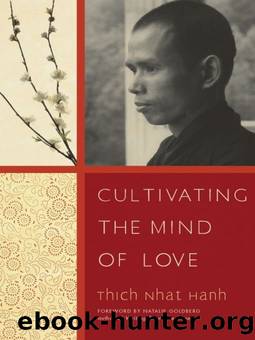Cultivating the Mind of Love by Thich Nhat Hanh

Author:Thich Nhat Hanh
Language: eng
Format: epub
Publisher: Parallax Press
Published: 2010-12-01T00:00:00+00:00
11
The Three Dharma Seals
Every authentic teaching of the Buddha must bear the three seals of the Dharma: impermanence, nonself, and nirvana. The first Dharma Seal is impermanence (anitya). Nothing remains the same for two consecutive moments. Heraclites said we can never bathe twice in the same river. Confucius, while looking at a stream, said, âIt is always flowing, day and night.â The Buddha implored us not just to talk about impermanence, but to use it as an instrument to help us penetrate deeply into reality and obtain liberating insight.
We may be tempted to say that because things are impermanent, there is suffering. But the Buddha encouraged us to look again. Without impermanence life is not possible. How can we transform our suffering if things are not impermanent? How can our daughter grow up into a beautiful young lady? How can the situation in the world improve? We need impermanence for social justice and for hope.
If you suffer, itâs not because things are impermanent. Itâs because you believe things are permanent. When a flower dies, you donât suffer much, because you understand that flowers are impermanent. But you cannot accept the impermanence of your beloved one, and you suffer deeply when she passes away. If you look deeply into impermanence, you will do your best to make her happy right now. Aware of impermanence, you become positive, loving, and wise. Impermanence is good news. Without impermanence, nothing would be possible. With impermanence, every door is open for change. Instead of complaining, we should say, âLong live impermanence!â Impermanence is an instrument for our liberation.
The second Dharma Seal is nonself (anatman). If you believe in a permanent self, a self that exists forever, a separate, independent self, your belief cannot be described as Buddhist. Impermanence is from the point of view of time; nonself is from the point of view of space.
When we practice the Diamond Sutra and look more and more deeply at the notions of self, person, living being, and life span, we discover that there are no boundaries between self and nonself, person and non-person, living being and non-living being, life span and non-life span. When we take a step on the green earth, we are aware that we are made of air, sunshine, minerals, and water, that we are a child of earth and sky, linked to all other beings, both animate and inanimate. This is the practice of non-self. The Buddha invites us to dwell in mindfulness in the concentrations (samadhi) of interbeing, nonself, and impermanence.
The third Dharma Seal is nirvana, which means âextinction,â the extinction of afflictions and notions. Human beingsâ three basic afflictions are craving, hatred, and ignorance. Ignorance (avidya), the inability to understand reality, is the most fundamental of these. Because we are ignorant, we crave for things that destroy us, and we get angry at many things. We try to grasp the world of our projections, and we suffer. Nirvana, the extinction of all afflictions, represents the birth of freedom. The extinction of one thing always brings about the birth of something else.
Download
This site does not store any files on its server. We only index and link to content provided by other sites. Please contact the content providers to delete copyright contents if any and email us, we'll remove relevant links or contents immediately.
The Way of Zen by Alan W. Watts(5809)
Ego Is the Enemy by Ryan Holiday(4000)
The Art of Happiness by The Dalai Lama(3391)
The Book of Joy by Dalai Lama(3234)
Why Buddhism is True by Robert Wright(2833)
Shift into Freedom by Loch Kelly(2698)
Spark Joy by Marie Kondo(2686)
Happiness by Matthieu Ricard(2530)
A Monk's Guide to a Clean House and Mind by Shoukei Matsumoto(2409)
The Lost Art of Good Conversation by Sakyong Mipham(2129)
The Meaning of the Library by unknow(2073)
The Third Eye by T. Lobsang Rampa(1887)
The Unfettered Mind: Writings from a Zen Master to a Master Swordsman by Takuan Soho(1863)
Anthology by T J(1758)
Red Shambhala by Andrei Znamenski(1752)
The Diamond Cutter by Geshe Michael Roach(1675)
Thoughts Without A Thinker: Psychotherapy from a Buddhist Perspective by Epstein Mark(1596)
Advice Not Given by Mark Epstein(1524)
Twilight of Idols and Anti-Christ by Friedrich Nietzsche(1498)
